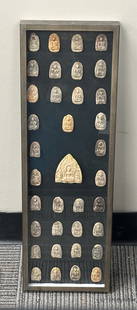




Item Details
Description
十六世纪至十七世纪 钺刀Dimensions: W 6.5in(16.5cm) H 6.25in(16cm) The overall structure and production technology of this Vajra Tomahawk show the characteristics of the late Ming Dynasty and the early Qing Dynasty. It demonstrates the skillful craftsmanship and superb artistic level of the imperial craftsmen. It is a model work of Tibetan Buddhist ritual instruments in the palace. Its main body is The copper is gilded and the blade is made of iron. The manufacturing process is complex. Copper was very precious at the time, and iron was the best material for making magical instruments. Tibetans believed that iron came from the gift of the Buddha (metallic iron), and many of its magical instruments It will be made of iron as raw material. The blade of this instrument is made of iron. The main body is densely covered with complicated and exquisite patterns using gilt copper technology. The half vajra is composed of double layers of eight strands, and a handle with upward lotus petals is attached below. Under the handle are the upward lotus petals and the Vajra Tomahawk. The blade is in the shape of a flame, engraved with dragon patterns, and the dragon body is elegant. The precise texture reflects the pinnacle of its craftsmanship; while the natural and flexible curves and shapes, as well as the crisp and solemn tension, stand incomparably at the pinnacle of Buddhist ritual art, making people fascinated. The Asian Art Museum in San Francisco and the Metropolitan Museum of Art in New York both have collections of Tibetan Buddhist esoteric instruments made by the Yongle period of the Ming Dynasty. However, hundreds of years have passed by, and the statues and ritual instruments that emperors of the past dynasties devoted to Tibetan Buddhist leaders have experienced several dynasties' efforts to uphold Taoism and suppress Buddhism, as well as various baptisms over time, and not a single one of them remains. The Vajra Tomahawk (Sanskrit: Vajra Tomahawk; Tibetan: Trigug) is a common magical weapon in Tibetan Buddhism, which represents the inviolability of the sacred Dharma and the intention to protect the Dharma. Tibetan Buddhist statues of tiger-faced Dakini, lion-faced Dakini, and Yamantaka all have images of holding ax swords. The yoke often has a sharp, flat blue iron body with a curved hook at the end. Its original meaning was chopping, scraping, hooking and other actions, and later it was extended to mean the wisdom of cutting off all emotions and perceptions. The sharp blade can completely destroy the two major "obstructions", namely the "obstruction of afflictions" and the "obstruction of knowledge", thereby achieving perfection. During practice, the blade of the sword can also cut through the six obscurations, namely "greed, breaking of precepts, anger, laziness, distraction, and ignorance", allowing people to enter a state of meditation. In the hands of the angry Vajra, the yue knife symbolizes the method of destroying all concepts. The relationship between Emperor Yongle and Tibetan Buddhism is quite profound. When he settled in Peiping as King of Yan, many former imperial teachers and eminent monks who had fled to avoid disaster lived in the many temples in the city. Zhu Di often visited them after he became a vassal, and Most of these eminent monks are Tibetan lamas, and over time they have gradually come to believe in Tibetan Buddhism. After the Battle of Jingnan, Zhu Di changed his reign to Yongle. In order to manage Tibet and flaunt his orthodox status through religion, Emperor Yongle ordered the Superintendent of Ceremonies to send officials and monks to Us Tibet to invite eminent monks to the capital, in addition to being granted the title of Imperial Master. In addition, he also gave generous gifts in return. From then on, adhering to the policy of "many confederations and many establishments", Emperor Yongle rewarded all the eminent Tibetan monks who came to Beijing to have an audience in Tibet. Over the course of several years, he basically controlled Tibet.
Condition
In good condition
Buyer's Premium
- 25% up to CA$5,000.00
- 20% above CA$5,000.00
Vajra Tomahawk 16th-17th century
Estimate CA$3,000 - CA$5,000
Starting Price
CA$1,000
Get approved to bid.
Shipping & Pickup Options
Item located in Toronto, Ontario, CASee Policy for Shipping
Local Pickup Available
Payment

2024 Spring Important Chinese Art Auction
Toronto, Ontario, CA
Recommended Items
Related Searches
TOP























































